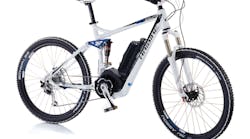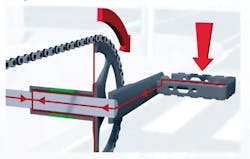A pedal-electric (pedelec) bike uses a special sensor to synchronize power from an electric motor with that of human pedaling for a smooth, power-assisted ride.
A bracket incorporates a shaft that holds the bike’s sprockets (crankset) to its frame while letting the crankset turn the rear wheel. Sensors generally monitor the speed at which the crankset spins. But a version of the bracket by FAG of Schaeffler Group USA Inc., Fort Mill, S.â C., uses a magnetoelastic sensor to measure the amount of torque coming from the rider’s pedaling.
The magnetoelastic sensor measures magnetic fields emanating from a magnetized segment of the crankset shaft using a fluxgate pickup. The field changes in proportion to how much the shaft is torqued. Within the material’s elastic limit, the fields change in a repeatable way, so the sensor tracks torques from 0 to 90 Nm on standard bikes and up to 300 Nm in versions designed for racing bicycles.
Measured crankset speed and pedal torque go to a controller that directs the motor to apply supplemental torque as needed. On pedelecs, the crankset accepts chain-transmitted pedal power from one side, motor power from the other.
This bracket also differs from those on other pedelecs because its magnetoelastic fluxgate sensor tracks the force from the left and right pedals with accuracy to 1%. Thus, the sensor-control-motor system is quick enough to smoothly compensate for short cyclical variations in torque as a rider repeatedly applies force to the right and left pedals. The motor only engages when the sensor detects the need for power assist, so the system makes pedelecs more efficient. In addition, the bracket uses FAG Generation C deep-groove ball bearings made of fiberglass-reinforced polyamide for 30% less friction than previous versions.
The bracket is also used in fully motorized e-bikes, ergometers, and physical-rehabilitation machines. A Bosch eBike Systems drive that uses the FAG bracket comes in eco, tour, sport, and speed versions, all programmed to supply motor power tailored to specific riding styles and terrains. Some versions can supply as much as 250% of the rider’s unassisted speed in assistance.
Resources: Bosch, Schaeffler Group



